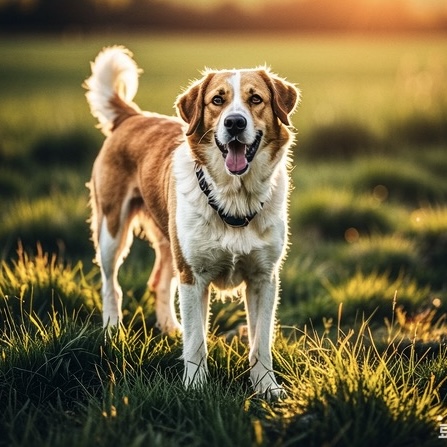
에 의해 TCMVET | 5월 27, 2024 | 개 암 및 종양
Mast cell tumors (MCTs) are among the most common types of skin cancer in dogs. They can vary widely in their behavior, from benign growths to highly aggressive cancers that spread rapidly. The decision of when to stop fighting a mast cell tumor in a beloved pet is one of the most challenging and heart-wrenching dilemmas a pet owner can face. This article aims to provide a comprehensive guide to understanding mast cell tumors, treatment options, and the critical factors to consider when making this difficult decision.
비만세포종양의 이해
Mast cells are a type of white blood cell involved in allergic reactions and inflammation. When these cells form tumors, they can appear as lumps on the skin or under the skin. Mast cell tumors are graded based on their appearance under a microscope, which helps predict their behavior and guide treatment. The three grades are:
- Grade I (low grade): These tumors are generally well-differentiated and have a low potential for spreading.
- Grade II (intermediate grade): These tumors have a moderate potential for spread and may behave unpredictably.
- Grade III (high grade): These tumors are poorly differentiated, aggressive, and have a high likelihood of spreading to other parts of the body.
치료 옵션
Treatment for mast cell tumors can include surgery, chemotherapy, radiation therapy, and targeted therapies. The choice of treatment depends on the tumor’s grade, location, size, and whether it has spread. Common approaches include:
- 외과적 제거: Often the first line of treatment, especially for Grade I and some Grade II tumors. Complete excision with wide margins can be curative.
- 화학 요법: Used for high-grade tumors or when surgery is not feasible. It can help control the disease and slow its progression.
- 방사선 치료: Often used post-surgery if the tumor margins are not clean or for tumors in difficult-to-operate locations.
- 표적 치료법: Drugs like tyrosine kinase inhibitors (e.g., Palladia) target specific pathways in cancer cells and can be effective for treating MCTs.
Factors to Consider
When evaluating whether to continue treatment or stop fighting the tumor, several factors need to be considered:
1. Quality of Life
The primary consideration should always be the dog’s quality of life. Symptoms of mast cell tumors can include pain, itching, swelling, and gastrointestinal issues due to histamine release. Owners should assess their dog’s comfort, happiness, and ability to perform normal activities. If treatments are causing significant discomfort without substantial improvement, it may be time to reconsider ongoing aggressive treatments.
2. Treatment Efficacy
Evaluate how well the treatments are working. If the tumor is not responding to treatment or continues to spread despite aggressive interventions, the likelihood of achieving a good outcome diminishes. At this point, continuing treatment may only prolong suffering without improving the quality of life.
3. Age and Overall Health
Older dogs or those with other significant health issues may not tolerate aggressive treatments well. In such cases, the risks and side effects of treatment may outweigh the potential benefits. A holistic view of the dog’s overall health and longevity should guide decision-making.
4. Financial Considerations
Treating mast cell tumors can be expensive, involving surgery, chemotherapy, and ongoing medications. Owners must realistically assess their financial ability to continue treatment and balance it with the expected outcomes.
5. Emotional and Ethical Considerations
The emotional toll on the family is significant. Owners should consider their emotional readiness to handle prolonged treatment and the potential loss of their pet. Ethical considerations also come into play, as owners must weigh the desire to prolong their pet’s life against the potential for prolonged suffering.
Palliative Care and Hospice
When the decision is made to stop fighting the tumor, focus shifts to palliative care. The goal is to maintain the best quality of life for as long as possible. Palliative care can include pain management, anti-inflammatory drugs, and medications to control symptoms like itching and gastrointestinal distress. In some cases, hospice care may be appropriate, providing comfort and dignity in the pet’s final days.
결론
Deciding when to stop fighting a mast cell tumor in a dog is profoundly personal and challenging. It requires a careful evaluation of the dog’s quality of life, the effectiveness of treatments, and the overall well-being of both the pet and the owner. Consulting with a trusted veterinarian, seeking second opinions, and leaning on support networks can provide guidance and comfort during this difficult time. Ultimately, the decision should center on what is in the best interest of the beloved pet, ensuring their remaining time is filled with love, comfort, and peace.

에 의해 TCMVET | 5월 27, 2024 | 개 암 및 종양
Pancreatic cancer in dogs is a serious and often life-threatening condition that requires prompt attention and care. This comprehensive guide will help pet owners understand the symptoms, diagnosis, and treatment options for pancreatic cancer in dogs, ensuring they are well-equipped to support their furry companions.
What is Pancreatic Cancer in Dogs?
Pancreatic cancer in dogs involves the abnormal growth of cells in the pancreas, an essential organ responsible for producing digestive enzymes and insulin. This type of cancer can be either exocrine (affecting the digestive enzyme-producing cells) or endocrine (affecting insulin-producing cells), with exocrine pancreatic adenocarcinoma being the most common and aggressive form.
Symptoms of Pancreatic Cancer in Dogs
The symptoms of pancreatic cancer in dogs can be subtle and easily mistaken for other health issues. Common signs to watch for include:
- 식욕 상실: Dogs with pancreatic cancer often lose interest in food, leading to weight loss.
- Vomiting and Diarrhea: Frequent vomiting and diarrhea are common due to the digestive disturbances caused by the tumor.
- Abdominal Pain: Your dog may exhibit signs of discomfort or pain in the abdomen, such as whining, restlessness, or avoiding being touched.
- 혼수: A general lack of energy and enthusiasm for activities they once enjoyed.
- Jaundice: Yellowing of the skin and eyes, indicating liver involvement or bile duct obstruction.
- Unexplained Weight Loss: Significant weight loss without a clear cause.
Diagnosis of Pancreatic Cancer in Dogs
Accurate diagnosis of pancreatic cancer in dogs involves a combination of clinical examination and diagnostic tests:
- 신체 검사: A thorough physical check by a veterinarian to identify any palpable masses or signs of discomfort.
- Blood Tests: To assess the overall health of your dog and identify any abnormalities in liver and pancreatic enzymes.
- 이미징 테스트: X-rays, ultrasound, or CT scans are crucial for visualizing the pancreas and detecting tumors.
- 생검: A tissue sample may be taken from the pancreas to confirm the presence of cancerous cells.
Treatment Options for Pancreatic Cancer in Dogs
Treatment for pancreatic cancer in dogs depends on the stage of the disease and the overall health of the dog. Common treatment options include:
- 수술: Surgical removal of the tumor is the most effective treatment if the cancer is detected early and has not spread.
- 화학 요법: Often used in conjunction with surgery or when surgery is not feasible. Chemotherapy helps to slow the growth of cancer cells and manage symptoms.
- 통증 관리: Ensuring your dog’s comfort with pain relief medications and supportive care.
- 영양지원: Special diets and supplements to help maintain your dog’s weight and nutritional status during treatment.
Prognosis and Life Expectancy
The prognosis for dogs with pancreatic cancer varies based on the cancer’s stage at diagnosis and the success of the treatment plan. Early detection and aggressive treatment can improve the outlook, but pancreatic cancer is generally associated with a poor prognosis due to its aggressive nature and late diagnosis.
결론
Pancreatic cancer in dogs is a challenging diagnosis for any pet owner. Understanding the symptoms, seeking prompt veterinary care, and exploring all treatment options can make a significant difference in your dog’s quality of life. Regular check-ups and paying attention to any changes in your dog’s behavior or health are key to early detection and treatment of this serious condition.
By staying informed and proactive, you can provide the best possible care for your furry friend, ensuring they receive the necessary support and treatment to manage pancreatic cancer effectively.

에 의해 TCMVET | 5월 27, 2024 | 개 암 및 종양
When a beloved pet is diagnosed with a mouth tumor, the emotional toll can be overwhelming. As a pet owner, it’s crucial to understand the costs involved in the surgical removal of a dog’s mouth tumor. This guide aims to provide a detailed breakdown of the factors influencing the cost of dog mouth tumor removal, helping you make informed decisions for your pet’s health and well-being.
Factors Influencing the Cost of Dog Mouth Tumor Removal
- Type of Tumor
- Benign vs. Malignant: Benign tumors typically require less extensive surgery compared to malignant ones, which might involve more complex procedures and follow-up treatments.
- Location and Size: Tumors in more accessible locations may be easier and cheaper to remove than those in tricky areas or larger in size, requiring more intricate surgery.
- Pre-Surgical Tests
- Blood Tests: Essential for evaluating the overall health of your dog and ensuring they can safely undergo anesthesia.
- Imaging (X-rays, CT scans, MRI): These tests help determine the extent of the tumor and plan the surgery accurately, adding to the overall cost.
- Surgical Procedure
- Veterinary Surgeon Expertise: More experienced surgeons may charge higher fees due to their expertise and higher success rates.
- Surgical Complexity: Complex surgeries involving specialized equipment or longer durations will naturally be more expensive.
- Anesthesia
- The type and duration of anesthesia required can significantly impact the cost. General anesthesia is typically used for tumor removals, necessitating thorough monitoring and specialized care.
- 수술 후 관리
- Hospitalization: Post-operative care may require your dog to stay in the veterinary hospital for observation and recovery, adding to the overall expense.
- 약물: Pain relief, antibiotics, and other medications are essential for your dog’s recovery and can contribute to the costs.
- Follow-Up Treatments
- Chemotherapy/Radiation: If the tumor is malignant, additional treatments such as chemotherapy or radiation may be necessary, substantially increasing the overall cost.
- 정기검진: Post-surgical follow-ups are crucial to monitor your dog’s recovery and detect any recurrence of the tumor early on.
Average Cost Breakdown
The cost of dog mouth tumor removal can vary widely based on the factors mentioned above. On average, pet owners can expect to pay:
- Basic Surgery: $500 – $1,500
- Advanced Surgery: $2,000 – $5,000
- Pre-Surgical Tests and Imaging: $200 – $1,000
- Anesthesia: $200 – $500
- Post-Surgical Care and Medications: $100 – $500
- Follow-Up Treatments (if needed): $1,000 – $5,000
Tips for Managing Costs
- 애완동물 보험: Invest in a good pet insurance plan that covers surgical procedures, which can significantly reduce out-of-pocket expenses.
- Financial Assistance: Look for veterinary financial assistance programs or non-profit organizations that help cover the cost of essential treatments.
- Payment Plans: Many veterinary clinics offer payment plans that allow you to spread out the cost of surgery over several months.
결론
Understanding the cost of dog mouth tumor removal is essential for pet owners facing this challenging situation. By being aware of the factors influencing the cost and exploring ways to manage expenses, you can ensure that your furry friend receives the best possible care without undue financial strain. Always consult with your veterinarian to get an accurate estimate tailored to your dog’s specific needs and circumstances.
By staying informed and prepared, you can make the best decisions for your pet’s health and well-being, ensuring they lead a happy and healthy life.

에 의해 TCMVET | 5월 26, 2024 | 개 암 및 종양
Facing the reality of a brain tumor diagnosis in a beloved dog is heart-wrenching. While modern veterinary medicine offers treatments that can prolong life and improve quality, there may come a time when euthanasia becomes the most humane option. This article explores the signs, considerations, and emotional aspects of deciding when to euthanize a dog with a brain tumor, providing guidance to pet owners during this difficult time.
개의 뇌종양 이해
Types of Brain Tumors
Brain tumors in dogs can be classified into two main categories:
- Primary Tumors: These originate in the brain and include gliomas, meningiomas, and choroid plexus tumors.
- Secondary Tumors: These metastasize to the brain from other parts of the body, such as hemangiosarcoma or mammary carcinoma.
뇌종양의 증상
Symptoms can vary depending on the tumor’s location and size but commonly include:
- 발작: One of the most common signs, ranging from mild to severe.
- 행동 변화: Increased aggression, confusion, or lethargy.
- Motor Dysfunction: Difficulty walking, balance issues, or paralysis.
- Vision Problems: Blindness or difficulty seeing.
- 고통: Indicated by whimpering, restlessness, or avoidance of touch.
치료 옵션
Medical Treatments
- 수술: Can be effective if the tumor is accessible, but not all tumors are operable.
- 방사선 치료: Helps shrink the tumor and alleviate symptoms.
- 화학 요법: Used less frequently due to the blood-brain barrier, but can be effective for certain tumor types.
- 완화 치료: Focuses on symptom management and improving quality of life without addressing the tumor directly.
Natural Remedies
- CBD 오일: May help with pain management and reducing seizures.
- 식단 변화: Antioxidant-rich diets and supplements can support overall health.
- 허브 보충제: Such as turmeric and milk thistle, which have anti-inflammatory properties.
When to Consider Euthanasia
삶의 질
The primary consideration should always be the dog’s quality of life. Ask yourself the following questions:
- Is my dog in pain? Chronic pain that cannot be managed effectively is a strong indicator.
- Can my dog perform daily activities? Eating, drinking, walking, and grooming without significant difficulty.
- Is my dog still enjoying life? Interest in favorite activities, social interactions, and responsiveness to the environment.
Veterinary Assessment
Regular consultations with your veterinarian are crucial. They can provide an objective assessment of your dog’s condition and prognosis, helping you make an informed decision.
Signs It May Be Time
- Uncontrollable Pain: Despite medication and treatment, the pain persists.
- Frequent Seizures: Seizures that are severe, frequent, and unmanageable.
- Loss of Mobility: Inability to stand, walk, or control bodily functions.
- Behavioral Deterioration: Severe anxiety, aggression, or confusion that affects safety and well-being.
- Significant Weight Loss: Inability to eat or drink, leading to rapid decline.
The Euthanasia Process
Preparing for Euthanasia
- Discuss with Your Vet: Understand the process, options for location (home or clinic), and any preparations needed.
- Plan the Day: Choose a quiet, comfortable setting, and consider who will be present.
- Emotional Preparation: Allow yourself to grieve and seek support from friends, family, or a counselor.
The Procedure
The euthanasia process is designed to be as peaceful and painless as possible for your dog:
- Sedation: Your dog may be given a sedative to relax them.
- Euthanasia Injection: Administered intravenously, leading to a painless and peaceful passing within minutes.
Coping with Loss
Grieving Process
Grieving the loss of a pet is natural and necessary. Allow yourself to feel and express your emotions. Memorializing your pet in a meaningful way can provide comfort.
Seeking Support
- 지원 그룹: Online or local groups can provide solace from others who understand your loss.
- Professional Help: Therapists or counselors specializing in pet loss can offer guidance.
- Family and Friends: Lean on your loved ones for emotional support during this time.
결론
Deciding to euthanize a dog with a brain tumor is one of the most challenging decisions a pet owner can face. Prioritizing your dog’s quality of life, consulting with your veterinarian, and recognizing the signs that it may be time are crucial steps in making this heart-wrenching decision. Remember, choosing euthanasia is a compassionate choice to prevent further suffering and allow your beloved companion to pass peacefully.
By staying informed and seeking support, you can navigate this difficult period with empathy and understanding, ensuring your dog’s final days are filled with love and comfort.

에 의해 TCMVET | 5월 26, 2024 | 개 암 및 종양
When a dog is diagnosed with a tumor, it can be a distressing experience for any pet owner. While conventional treatments like surgery, chemotherapy, and radiation are often necessary, there are natural methods that can support these treatments and help shrink tumors in dogs. This comprehensive guide explores various natural ways to shrink tumors, improve overall health, and enhance the quality of life for your beloved pet.
개의 종양 이해
Types of Tumors
Tumors in dogs can be classified into two main categories:
- 양성 종양: These are non-cancerous and typically do not spread to other parts of the body. Common benign tumors include lipomas and sebaceous adenomas.
- 악성 종양: These are cancerous and can spread (metastasize) to other parts of the body. Examples include mast cell tumors, lymphoma, and osteosarcoma.
Causes of Tumors
The exact cause of tumors in dogs is often unknown, but several factors may contribute:
- Genetics: Certain breeds are more prone to specific types of tumors.
- Environment: Exposure to toxins and pollutants can increase the risk.
- 다이어트와 생활 방식: Poor nutrition and lack of exercise can contribute to tumor development.
Natural Ways to Shrink Tumors
1. 다이어트와 영양
A balanced diet is crucial for maintaining your dog’s overall health and supporting their immune system.
Anti-Cancer Diet
- 고품질 단백질: Ensure your dog gets plenty of high-quality protein from sources like lean meats, fish, and eggs.
- 항산화제: Foods rich in antioxidants, such as blueberries, spinach, and carrots, help fight free radicals and reduce oxidative stress.
- 오메가-3 지방산: Found in fish oil, flaxseed, and chia seeds, omega-3 fatty acids have anti-inflammatory properties and can help slow tumor growth.
- 저탄수화물: Cancer cells thrive on carbohydrates. Reducing carbohydrate intake can help starve the cancer cells.
2. 허브 보충제
Several herbs have properties that may help shrink tumors and support overall health.
강황(커큐마 롱가)
- 혜택: Contains curcumin, which has strong anti-inflammatory and antioxidant properties.
- How to Use: Add a small amount to your dog’s food, gradually increasing the dose based on your dog’s size and tolerance.
밀크씨슬(실리범 마리아눔)
- 혜택: Supports liver function and detoxification, which is crucial during cancer treatment.
- How to Use: Available in powder, capsule, or liquid form. Consult your vet for the correct dosage.
Astragalus (Astragalus membranaceus)
- 혜택: Boosts the immune system and enhances overall vitality.
- How to Use: Can be given as a tincture or in powdered form. Follow veterinary advice for dosage.
3. CBD Oil
CBD oil has gained popularity for its potential to reduce pain, inflammation, and anxiety in pets.
- 혜택: May help reduce tumor size, alleviate pain, and improve appetite.
- How to Use: Administer based on product instructions and your vet’s guidance. Start with a low dose and monitor your dog’s response.
4. Acupuncture and Traditional Chinese Medicine (TCM)
Acupuncture and TCM can be beneficial in managing cancer symptoms and improving overall well-being.
- 혜택: Helps balance the body’s energy, reduce pain, and support the immune system.
- How to Use: Consult a certified veterinary acupuncturist for a tailored treatment plan.
5. Regular Exercise
Keeping your dog active is essential for their physical and mental health.
- 혜택: Regular exercise helps maintain a healthy weight, boosts the immune system, and improves mood.
- How to Use: Tailor the exercise routine to your dog’s capabilities, ensuring not to overexert them.
6. Regular Veterinary Check-Ups
Routine veterinary visits are vital for monitoring your dog’s health and adjusting treatment plans as needed.
- 혜택: Early detection of any changes in tumor size or new health issues.
- How to Use: Schedule regular check-ups and follow your vet’s recommendations for tests and treatments.
결론
While conventional treatments are often necessary for managing tumors in dogs, incorporating natural methods can provide additional support and improve your pet’s quality of life. A balanced diet, herbal supplements, CBD oil, acupuncture, regular exercise, and routine veterinary check-ups are all valuable components of a comprehensive care plan.
Always consult with your veterinarian before starting any new treatments or making significant changes to your dog’s diet or lifestyle. By taking a holistic approach, you can help your dog fight cancer and enjoy a happier, healthier life.

에 의해 TCMVET | 2024년 5월 25일 | 개 암 및 종양
항문샘 선암종은 개의 항문샘에서 발생하는 악성 종양입니다. 이 유형의 암은 상대적으로 드물지만 매우 공격적이어서 종종 영향을 받은 개에게 심각한 건강 문제와 불편함을 초래합니다. 항문 선암종의 증상, 진단 방법 및 치료 옵션을 이해하는 것은 조기 개입과 이러한 애완동물의 삶의 질을 향상시키는 데 중요합니다. 이 기사에서는 애완동물 주인과 수의사에게 개의 항문선 선암종을 관리하는 모범 사례를 알리는 것을 목표로 이 상태에 대한 포괄적인 개요를 제공합니다.
항문선 선암종이란 무엇입니까? 항문선 선암종은 개의 항문 근처에 위치한 분비선에서 발생하는 암의 일종입니다. 이 땀샘은 냄새를 나타내는 액체를 생성하는 역할을 합니다. 선암종 형태는 근처 조직을 침범하여 림프절, 간, 폐 등 신체의 다른 부위로 전이될 수 있는 선상피 세포의 통제되지 않는 성장이 특징입니다.
증상: 항문선선암종의 증상을 조기에 인지하는 것은 치료 결과에 큰 영향을 미칠 수 있습니다. 일반적인 징후는 다음과 같습니다:
- 항문 근처의 부기 또는 덩어리: 항문 주위에 눈에 띄는 덩어리나 부기가 있습니다.
- 스쿠팅 및 핥기: 불편함으로 인해 휙휙 움직이는 행동이 증가하거나 항문 부위를 과도하게 핥는 현상이 나타납니다.
- 배변 곤란: 배변에 힘을 주거나 대변의 농도가 변합니다.
- 출혈 또는 분비물: 항문에서 혈액이 나오거나 비정상적인 분비물이 나옵니다.
- 고통과 불편함: 앉아 있거나 배변을 할 때 통증이 나타나는 증상입니다.
- 전신 증상: 진행된 경우 개는 체중 감소, 무기력, 식욕 감소 및 전반적인 허약함을 나타낼 수 있습니다.
진단: 항문선 선암종의 정확한 진단에는 여러 단계가 포함됩니다.
- 신체 검사: 항문 부위의 종괴나 이상을 발견하기 위한 수의사의 철저한 검사입니다.
- 미세 바늘 흡인(FNA): 세포학적 검사를 위해 덩어리에서 작은 세포 샘플을 추출하는 최소 침습적 절차입니다.
- 생검: 조직병리학적 분석을 위해 종양에서 조직 샘플을 외과적으로 제거하여 최종 진단을 제공합니다.
- 이미징: 종양의 정도를 평가하고 전이를 확인하기 위한 엑스레이, 초음파, CT 스캔 또는 MRI와 같은 기술.
- 혈액 검사: 개의 전반적인 건강을 평가하고 동반 질환을 식별하기 위한 종합적인 혈액 검사입니다.
치료: 항문 선암종의 치료 계획은 암의 단계와 개의 전반적인 건강 상태에 따라 다릅니다. 일반적인 치료 옵션은 다음과 같습니다.
- 수술: 국소 항문샘 선암종의 일차 치료법은 종양을 수술적으로 제거하는 것입니다. 여기에는 완전한 항문낭절제술(영향받은 샘 제거)과 주변 조직이 포함될 수 있습니다. 어떤 경우에는 종양이 퍼진 경우 더 광범위한 수술이 필요합니다.
- 방사선 치료: 남아있는 암세포를 제거하고 재발 위험을 줄이기 위해 수술 후 방사선 요법이 권장될 수 있습니다. 또한 진행된 경우 증상을 완화하기 위해 완화적으로 사용할 수도 있습니다.
- 화학 요법: 화학요법은 단독으로 사용하거나 특히 전이된 암의 경우 수술 및 방사선과 함께 사용할 수 있습니다. 질병의 확산을 통제하고 삶의 질을 향상시키는 데 도움이 됩니다.
- 완화 치료: 완치적 치료가 불가능한 경우, 완화 치료는 증상을 관리하고 개의 편안함과 삶의 질을 유지하는 데 중점을 둡니다.
예후: 항문샘 선암종에 걸린 개의 예후는 종양의 크기, 전이 정도, 치료 성공 여부 등의 요인에 따라 크게 달라집니다. 조기에 발견하고 적극적으로 치료하면 좋은 결과를 얻을 가능성이 높아집니다. 그러나 이 암의 공격적인 성격으로 인해 특히 진행된 단계에서 발견되는 경우 예후가 조심스러워지는 경우가 많습니다.
결론: 개의 항문샘 선암종은 심각하고 잠재적으로 생명을 위협할 수 있는 질환으로 즉각적이고 포괄적인 수의학적 치료가 필요합니다. 증상에 대한 인식과 조기 개입은 치료 결과를 개선하는 데 중요합니다. 애완동물 소유자는 개에서 항문샘 문제의 징후를 발견하면 수의사의 조언을 받아야 합니다. 수의학 종양학의 발전은 계속해서 새로운 희망을 제시하고 있지만, 항문선 선암종의 공격적인 성격은 정기적인 수의학 검진과 조기 발견의 중요성을 강조합니다.







